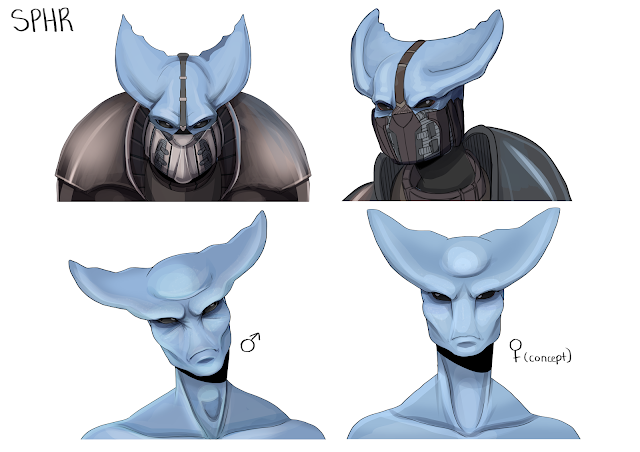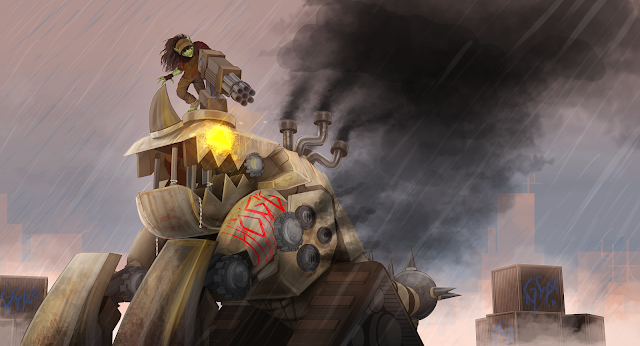Project Evaluation - Real worlds
Part 1: Character design, research and game proposal:
For the first half of this project, we created a research dossier around Deadzone, licensing and IP usage before moving onto creating character designs to fit in with our chosen factions. I actually really enjoyed looking into the lore of Deadzone, I don't usually like tabletop war games and thus never really looked into the types of games out there but looking into the worldbuilding, genre and analysing the character designs really drew me in and made me feel excited to work on this project. I liked the challenge of identifying what made a faction unique and how to translate that into my own designs, and tying in with this I pushed myself to do something I am not as confident in, that being hard surface designs. I learnt a new approach by utilizing 3D models to draw on top of which massively helped in my idea generation for the Hogg and Swine, I enjoyed the process of making the 3D model as well as figuring out how to render it in keeping with my art style. 3D modelling is something I've really struggled with in the 3 nearly 4 years I've been at Confetti, and this year I set myself a personal goal to practice more 3D this year to build up my skill. I'm really glad I did this, although I definitely need more practice in optimizing 3D models for games by using UV mapping, retopology, and texturing, I certainly feel more confident in 3D modelling for the purpose of draw overs.
Having a live client brief was also great, I got to understand and work to the expectations an employer will put on me, and the constructive criticism I got from the Mantic guys was incredibly useful. I was able to fix things I hadn't even thought about to improve my designs to better fit in with their IP, a great example of this is their tips on improving Katya's body shape, tail and the spikes on the Hogg and Swine. Not only did these details improve my character designs overall, but it made them feel more realistic and logical. When creating the research dossier, I learnt a lot of useful information about licensing and IP usage, which is always useful information to bare in mind for the future, especially as I would maybe like to make my own tabletop games in the future.
For the research for the game proposal, my eyes were opened to the fact that my horizons for videogames are quite small, I should look into more games over the summer to broaden my horizons to understand how to make better concepts for games. It is really important to have a good library of reference to identify what makes a popular game popular. Even if I don't play the games, watching playthroughs is just as helpful.
On a whole, I really enjoyed working on this brief, It gave me opportunities to do things I like and feel more confident in such as character design, whilst also highlighting things I need to improve on. One of the things I wish I had done better is creatin more observational sketches to begin with. Although I did go back and do some to rethink my design choices, I admit I was feeling a bit overwhelmed at that stage with all the different projects, though moving forward I will make sure to do my full research and ensure I am confident on my research material before starting a drawing.
Looking at the artwork I've made for this part of the project, I really feel proud of the designs I made, I think they fit quite well into the visual style of Deadzone, I have to admit the final art of Hogg and swine is perhaps one of my favourite pieces I've done all year.
Below I have included some of the main art pieces I created for this half of the project:
Part 2: 3D asset design, Building design & Environment art:
For this second half of the project, I was faced with something that is outside of my comfort zone. Architectural designs are not my strong suit, I really struggle coming up with ideas for unique looking buildings and find environments on a whole hard to lay out. However this half of the brief was good practice to work on that area and I was somewhat excited to learn new techniques to build up my skill in this area.
When doing my visual research into Brutalist architecture, I was genuinely interested to see what makes brutalist architecture iconic, what the purpose behind it was, and exploring materials and shapes that I could use to make my building unique.
Although I was initially quite nervous about the iterative design process, I ended up trying out a new technique that helped me draw building ideas much quicker and much more uniquely, i then found it much easier to transfer these ideas into final designs. Similarly to the first half of this project, I also surprisingly enjoyed the 3D modelling process. It was really fun to put together the scene, and in the end I had to stop myself from getting carried away in making too many models.
Building a scene up like this was much easier than sketching it out, especially when it comes to more urban settings, I tend to work better when I am working intuitively with more organic shapes, by modelling my scene and being able to physically push and pull elements to where I want to be without stressing over perspective was really helpful. Looking at my model and considering how I would turn this into a 3D paint over, truthfully I was quite worried. I've never really done anything like this before so I didn't really know where to start.
Getting some advice on looking at benchmark artist helped, it gave me a solution to the problem of not knowing where to start and I am very grateful for the guidance from my tutors on how to do something like this. It gave me a lot more confidence to give it a try, was excited to learn something new in the process. I do think that I could have improved on composition and lighting in my final piece, I feel it looks a little unfocused and the viewer's eye is not guided through the scene as well as I would have liked. I will also try to step out of my comfort zone next time with my art style, try to be more loose, intuitive and maybe incorporate photo bashing in some textures to save time. All of which are valuable skills to learn for the role of a concept artist in the games industry. Although I have a lot to improve on, overall I enjoyed the process of trying something new and I feel inspired to try this again in the future.



















Comments
Post a Comment